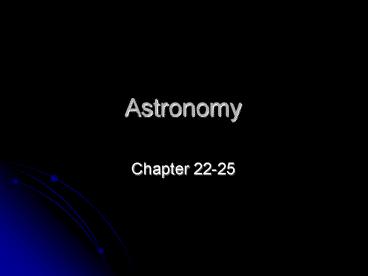Astronomy PowerPoint PPT Presentation
1 / 28
Title: Astronomy
1
Astronomy
- Chapter 22-25
2
Warm Up Sept 7
- http//www.youtube.com/watch?vjRXQsQKGqIU
creepy twinkle - http//www.youtube.com/watch?vyCjJyiqpAuU cute
twinkle - Compare and contrast each version using a Venn
Diagram - Which one do you like more? Why?
- Which one best describes human curiosity towards
outer space? WHY?
3
Time Line
- Create a time to include each of the following
people (include their discovery). - Aristotle
- Eratosthenes
- Hipparchus
- Aristarchus
- Claudius Ptolemy
- Nicolaus Copernicus
- Tycho Brahe
- Johannes Kepler
- Galileo Galilei
- Sir Isaac Newton
4
What is the Golden Age of Astronomy?
- The shift away from the idea of a Geocentric
Universe.
5
What is Modern Astronomy?
- Nicolaus Copernicus (1473-1543)
- Earth is just a planet
- Universe is sun centered
- Mercury, Venus, Earth, Mars, Jupiter, and Saturn
- Circular orbits around sun
- Tycho Brahe (1546-1601)
- Used pointers to estimate distance
- Pointers think big protractor
- Mentor Kepler
6
Who was Johannes Kepler (1571-1630)?
- Brahes observations of Mars
- Noticed that the orbit was not Circular
- Kepler used his QAs to form 3 Laws of Planetary
Motion - 1st Law
- Ellipse (Oval)
- 2 foci
- Star
7
Laws of Planetary Motion
- 2nd Law
- Sun sweeps over equal areas in the same amount of
time. - Close to sun faster
- Away from sun slower
- 3rd Law
- Orbital Period (time) of planet is proportional
to distance from the sun (P2d3), expressed in AU
units (1AU 1.5Million Km)
8
Who is Galileo Galilei?(1564-1642)
- Telescope
- Behavior of moving objects
- Observation supported Copernicuss view of the
universe - Moons of Jupiter (4) Earth is not the center of
all universal motion - Planets are circular disc must be Earth-like
- Venus has phases like the moon orbits light
source (sun) - Moons surface not smooth validated others who
named areas based on features (Sea of
Tranquility) - Sun has dark regions tracked movement est.
rotation period of sun under 1 month
9
What is the Law of Universal Gravitation?
- Sir Isaac Newton (1642-1727)
- ? Kepler some force pushes the planets along
their orbits - ? Galileo no force is required to keep an object
in motion - Inertia
- Every body attracts directly proportional to mass
inversely proportion to distance2 b/w the
bodies - Revised Keplers 3rd law (mass)
10
What are Earth Motions?
- Rotation
- Spinning on axis (day/night)
- Solar day
- noon to noon
- Sidereal day
- Based on a distant star
- 23hr 56 min
- Distance to the stars change by tiny increments
- Sun changes by 1 a day
11
(No Transcript)
12
Earth Motions Cont.
- Revolution
- Moving around another body
- Distance of the sun to the Earth _at_150 million km
- Elliptical Orbit
- Perihelion _at_ January 3
- 147 million km
- Aphelion _at_July 4
- 152 million km
13
(No Transcript)
14
Earth Motions Cont.
- Precession
- Change in tilt of axis
- 23.5 always the same
- Slow _at_ 26 000 years
- Changes North Star
- Polaris to Vega
- Nutation
- Wobbling around the axis
- Caused but the moons pull
- Slight seasonal change.
- Remember Galaxies on the move!
15
What are Axis Seasons?
Why do different season exist?
16
Axis Seasons cont.
17
Moon (Satellite) Motions
- Revolution 1month (29 ½ days)
- Ave. distance 384 401Km (6)
- Perigee closest to Earth
- Apogee farthest
- Phases of the Moon
- Waxing
- Waning
18
(No Transcript)
19
How do Eclipses work?
20
What is Barycenter?
- The center of mass is the balance point between
two orbiting bodies, like a seesaw.
21
The Sun
- Average Star
- Some Stats
- Diameter 109 Earth diameters
- Volume 1.25 million times Earths
- Mass 332,000 times Earths
- Density 1/4th of solid Earth
22
Sun Structure
- Structure
- the Solar Interior
- Photosphere
- 2 Atmospheric Layers
- Chromosphere
- Prominences
- Corona
- Solar Winds
23
(No Transcript)
24
Solar Flares Sunspots
- Solar Flares
- Auroras
- Sunspots
- 11 year cycle
- Last days to weeks
25
The Solar interior
- Nuclear Fusion
- Emc2
- It takes very little hydrogen to make a lot of
energy. - Most of the hydrogen is not converted to energy.
26
Other Stuff
- Scientific Methods Quiz Redo
- A problem is a question to be answered!!!!!
- Answer the QUESTION!!!!!!!!!!!!!!!!
- Do not for get the problem/hypothesis
relationship!!!!! - Example Problem
- Does the presence of grain-eaters in the desert
environment cause a decrease in wildflower
diversity? - Example Hypothesis
- If grain-eaters are eliminated from the
environment by a fence, then the wildflower
diversity will increase by 20. - Independent Variable
- Dependent Variable
- Write so anyone knows what you are saying!!!!!!!
27
Other Stuff
- On the Scientific Method Quiz, if your grade is
- 13-14 Awesome Job!!
- 11-12 Good, but needs some work.
- 7-10 OK, but what are you at a loss about?
- 0-6 Get help before the test Wednesday!!!
- On the Astronomy Quiz, if your grade is
- 19-20 Stellar Performance!!
- 18 Awesome Job!!
- 15-17 Good, but needs some work.
- 9-14 Ummmhhhh I think you need to study!!!
- Below a 9 Seek help before Wednesday test!!!
28
The Golden Age Astronomers
Aristarchus (312-230BC)
Aristotle (384-322BC)
The Earth is round.
1st to believe in heliocentric universe

